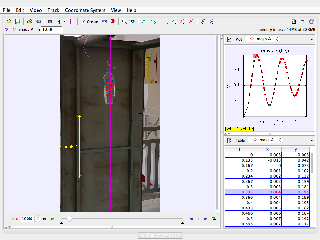

About
Considering spring constant of a rubber band, we investigate about how the weight of bottle and water has an effect on the extension of the rubber band
For Teachers
Credits
Author: Julie Quah, Lim Siew Eng, Ezzy
Contact: This email address is being protected from spambots. You need JavaScript enabled to view it., This email address is being protected from spambots. You need JavaScript enabled to view it., This email address is being protected from spambots. You need JavaScript enabled to view it.
Document Brief: Title: "Tracker Oscillating Up and Down Bottle"
This document examines the oscillatory motion of a bottle as it moves up and down in a liquid medium. The study delves into the forces at play, including buoyancy, gravity, and damping, to understand the dynamics of oscillatory motion and equilibrium.
Study Guide:
Objective: Analyze the oscillatory motion of a bottle moving up and down in a liquid, exploring factors like buoyancy, restoring forces, and damping effects.
Key Concepts:
-
Buoyancy:
-
The upward force exerted by a fluid on an object submerged or partially submerged.
-
-
Oscillatory Motion:
-
A repetitive motion about an equilibrium position, influenced by restoring forces and damping.
-
-
Restoring Force:
-
The force that drives the object back toward its equilibrium position, proportional to its displacement.
-
-
Damping:
-
The reduction in amplitude of oscillations due to energy loss, often caused by fluid resistance.
-
Experiment Overview:
-
Setup: A bottle is placed in a liquid and manually displaced, initiating oscillatory motion.
-
Procedure:
-
Observe the bottle’s motion as it oscillates up and down.
-
Record key variables such as amplitude, period, and damping rate.
-
-
Observation Points:
-
How the amplitude changes over time.
-
The role of buoyancy and gravity in maintaining oscillations.
-
The effects of liquid viscosity on damping.
-
Questions to Consider:
-
What forces act on the bottle during its motion?
-
How does the liquid’s viscosity affect the damping of oscillations?
-
What factors determine the equilibrium position of the bottle?
Applications:
-
Understanding oscillatory systems in natural and industrial processes.
-
Designing devices that rely on buoyancy and damping, such as float valves and wave energy converters.
FAQ:
-
Why study the oscillatory motion of a bottle? The bottle’s motion provides a simple yet effective model to explore fundamental principles of oscillatory dynamics and fluid mechanics.
-
What determines the equilibrium position? The equilibrium position is where the upward buoyant force equals the downward gravitational force on the bottle.
-
How does damping affect oscillations? Damping reduces the amplitude of oscillations over time due to energy loss, eventually leading the bottle to rest at its equilibrium position.
-
Would results differ in a less viscous liquid? Yes, lower viscosity reduces damping, allowing the bottle to oscillate longer before coming to rest.
-
What real-world systems use similar principles? Applications include designing buoys, understanding wave dynamics, and optimizing oscillatory mechanisms in engineering systems.
- Details
- Written by leongster
- Parent Category: 02 Newtonian Mechanics
- Category: 09 Oscillations
- Hits: 5566
